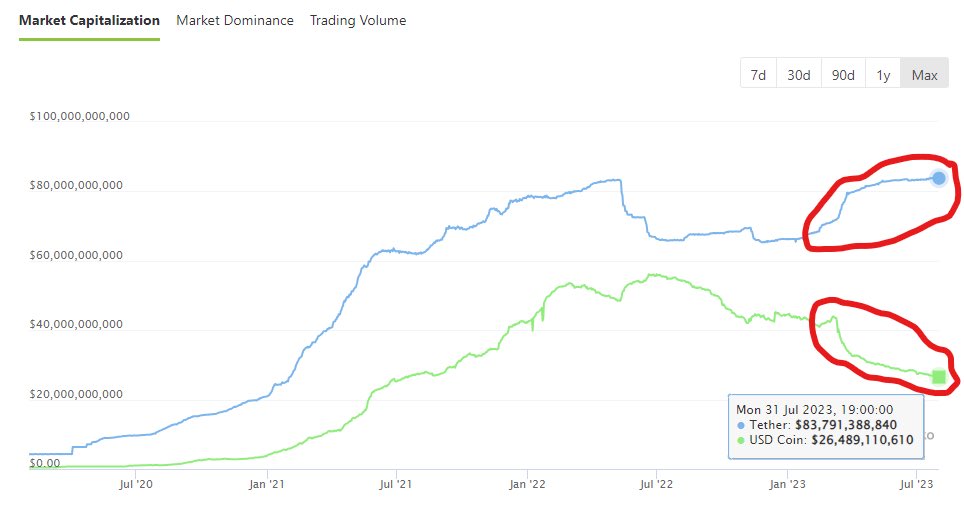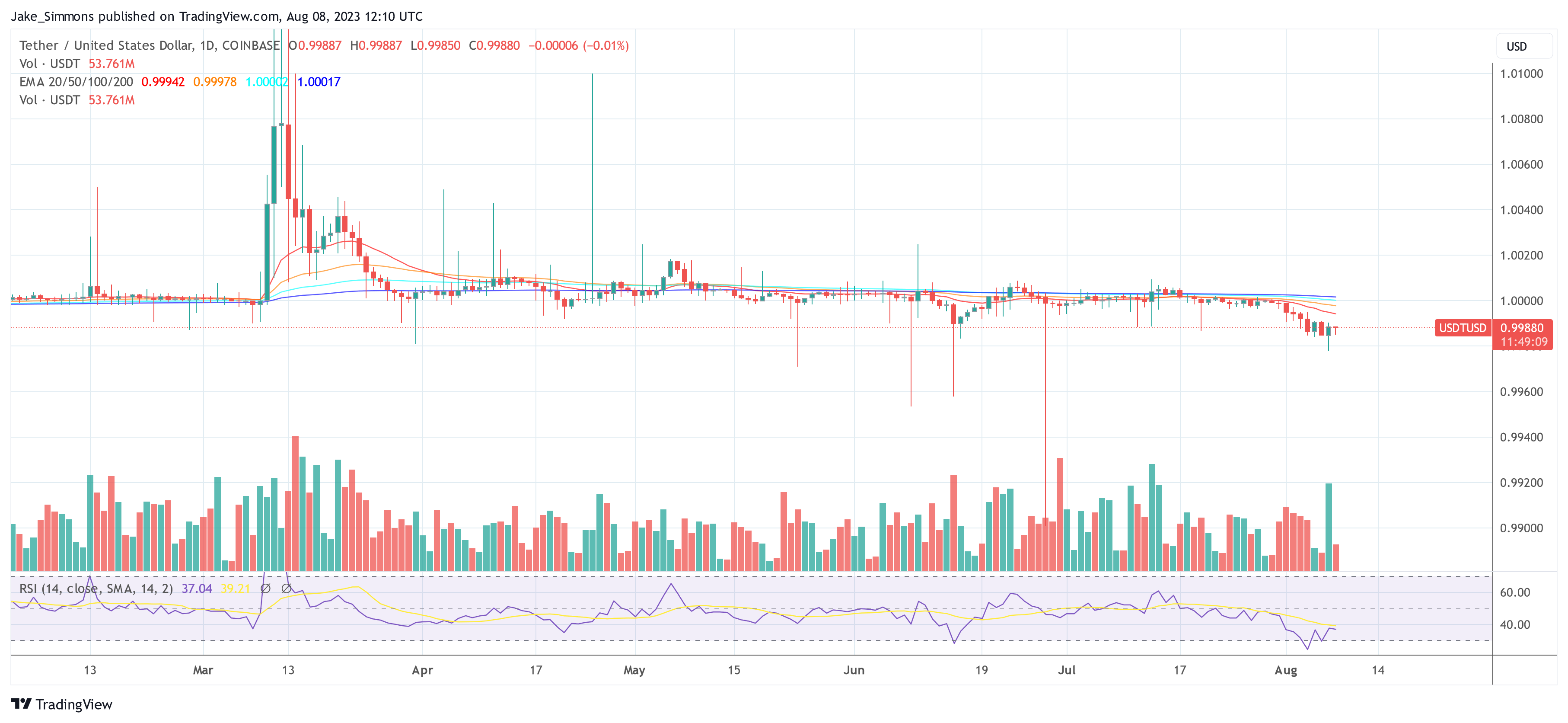There is a new stablecoin brewing in the crypto market since last week. As things stand, the main players are Binance, Tether, USDC and Tron’s Justin Sun. While the connections are not yet clear and need further investigation, reputable research firms and crypto analysts have set out to untangle the battle for stablecoin supremacy.
Tether (USDT) Is Depegged Since 8 Days
For eight days already, the stablecoin Tether (USDT) has been facing a slight depeg. While a slight deviation from the US dollar was quickly offset by market makers in the past, this time is different. And the reasons are mysterious.
According to a report by research firm Kaiko, “It is unclear why traders are swapping out of USDT as there has been no clear bearish catalyst.” Tether’s CTO Paolo Ardoino suggested that the selling could be “foul play” from competitors, closely timed with Binance’s listing of the new stablecoin FDUSD on July 26th.
Isn’t it interesting that USDt is being pressured down (slightly, within 10bps, just to push market makers to react), and USDc, the main competitor that you would expect being gaining from the situation, is redeemed heavily nevertheless, while suddenly a competitor born 2 days…
— Paolo Ardoino
(@paoloardoino) August 3, 2023
Remarkably, despite promotional efforts, FDUSD trade volumes have been underwhelming on Binance so far. Kaiko notes, “The lackluster market response to the zero-fee FDUSD pairs is surprising given that these types of promotions typically have a strong impact on overall trading activity.”
This reluctance to engage with FDUSD is puzzling, especially when compared to the success of other stablecoins like TrueUSD (TUSD, which is like FDUSD also rumored to be emitted by Justin Sun). In conclusion, Kaiko states that there’s something off:
FDUSD conspiracy or not, it is clear that the stablecoin wars are back on track. Despite Tether’s less-than-perfect track record on transparency, traders have historically turned a blind eye, which means the heavy selling is indeed mysterious.
War Between Binance And Tether?
Adam Cochran, a renowned crypto analyst, observed on Monday, “Even with banks open in Asia and Europe and US coming online, USDT peg is off by the deepest sustained amount since the FTX fall out.” He further observed selling pressure from Binance funded accounts and the potential involvement of CZ, Binance’s CEO, in propping up new stablecoins.
Meanwhile, Tether CTO Ardoino and Binance CEO Changpeng Zhao (“CZ”) exchanged blows on Twitter. Ardoino stated that the unusual transactions were “attacks” on Tether by counterparties. CZ subsequently tweeted that Tether is a “black box,” which is why he is replacing it with his own stablecoins such as TUSD and FDUSD. Cochran stated,
Even if this is an attack by CZ to prop up his new stablecoins. […] This is the least confidence we’ve seen in the USDT peg by market makers in a long time. […] Hopefully it ends up just being a CZ vs Paolo fight – but worth keeping an eye on.
USDT Vs. USDC
Meanwhile, Jeremy Allaire, CEO and founder of Circle, the issuer of USDC, emphasized the transparency and liquidity of USDC. He tweeted, “USDC Liquidity. Over the past month, we’ve issued $5B USDC, and have redeemed $6.6B USDC… We don’t charge fees to mint and burn USDC.” Allaire was probably alluding to Tether, which has a bad reputation for its reserve attestations.
Travis Kling, founder of Ikigai Fund, responded with a chart to Allaire, showing USDT’s rising market cap since March, while USDC was losing market shares. He asked, “I agree Jeremy. Transparency really matters. To that end, why do you think this chart looks like this?”

Cochran speculated on this, suggesting a potential strategy by Tether to sell at a loss, withdraw USD from USDC, and reissue it as USDT to attack its competitor. He suggests that Tether could exploit a relatively small cost (10bps) to sell at a loss, then withdraw USD from USDC, only to reissue it as USDT.
By placing the underlying assets in money market funds, Tether could potentially achieve a 500bps/year return. This tactic, as Cochran points out, is not just a simple financial move but a strategic assault on its competitors.
Furthermore, the analyst highlights the changing dynamics of Tether’s primary trading markets. With FTX, Binance, and Binance US once being the main contributors to USDT, the landscape is shifting. Two of these sources are no longer in play, and Binance transitioning to new stablecoins like FDUSD and TUSD.
Cochran believes that Binance, recognizing the profitability of issuing stablecoins, might be pushing Tether into the DAI DSR and promoting their new stablecoins.
The Justin Sun Connection
Adding to the intrigue are the actions of Justin Sun. Rumors have long suggested deep connections between Binance CEO “CZ” and Sun. Sun’s recent financial maneuvers, including significant withdrawals from Huobi Global to Binance and a subsequent deposit of $200 million in USDT to Huobi, have raised eyebrows.
Cochran’s investigations suggest that Sun might be employing tactics to show confidence in Huobi amidst rumors of insolvency, further fueling the stablecoin wars:
Justin Sun just yoinked $200M USDT out of JustLend (the USDT he has taken from Huobi) back to his personal wallet, and then transferred to a new address… […] So it looks like he’s withdrawn from the Huobi hot wallet, used the funds then deposited through his deposit address to show confidence. The ol’ Alameda trick.
Connecting the Dots
Remarkably, Chase Coleman’s observation on Twitter raise further questions regarding the ongoing stablecoin war:
Let’s make it weirder: USDT + TUSD (TUSD only since 6/14, local low on $BTC) market caps: +18.56B
USDC market cap: -$18.56B
The unfolding events suggest a high-stakes game of chess in the stablecoin arena. With Tether’s transparency issues, Binance’s new stablecoin listings, and Justin Sun’s rumored involvement, the stablecoin war seems on. While all the connections are far from clear, a battle seems to be raging in the background.
At press time, USDT was still slightly depegged.






